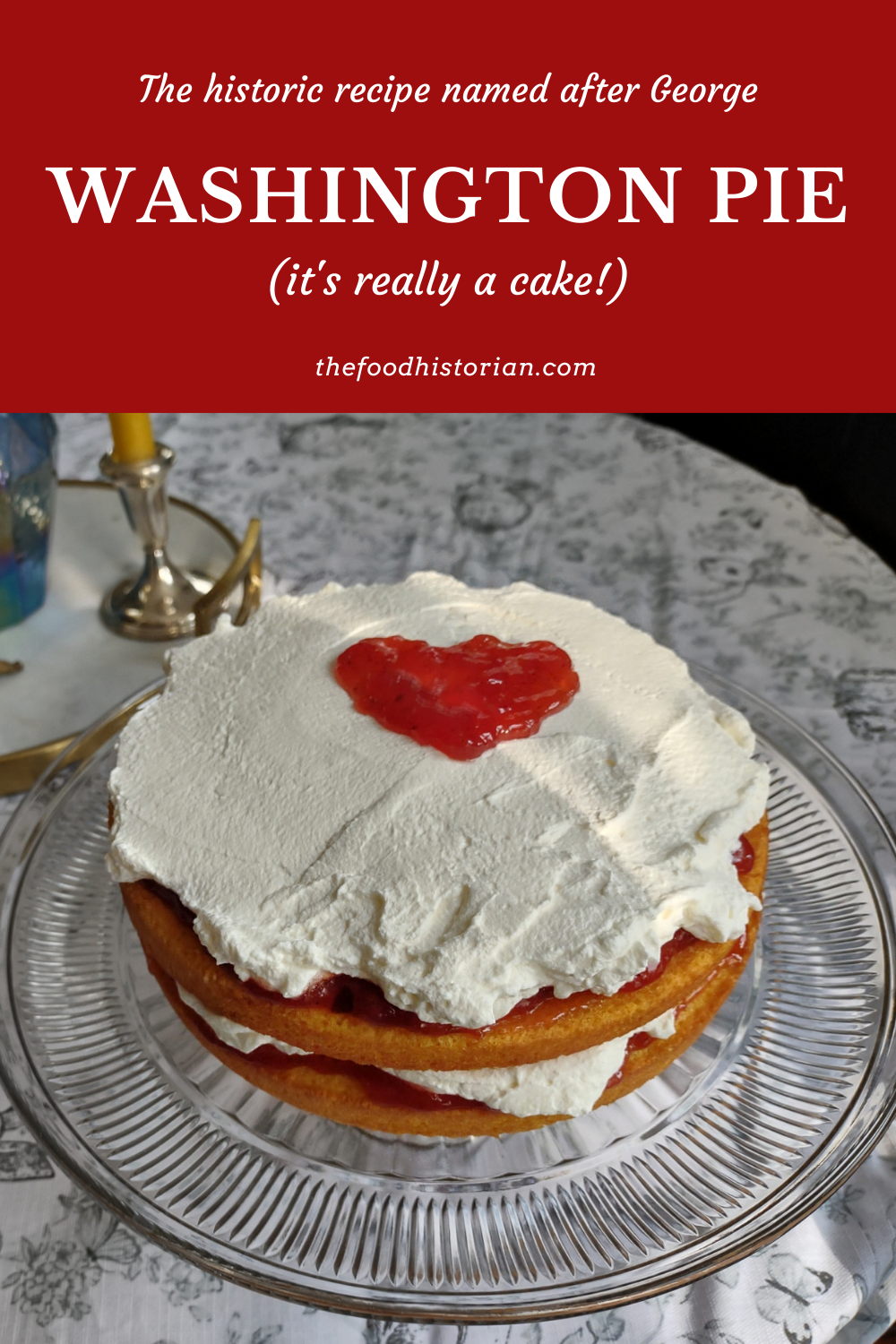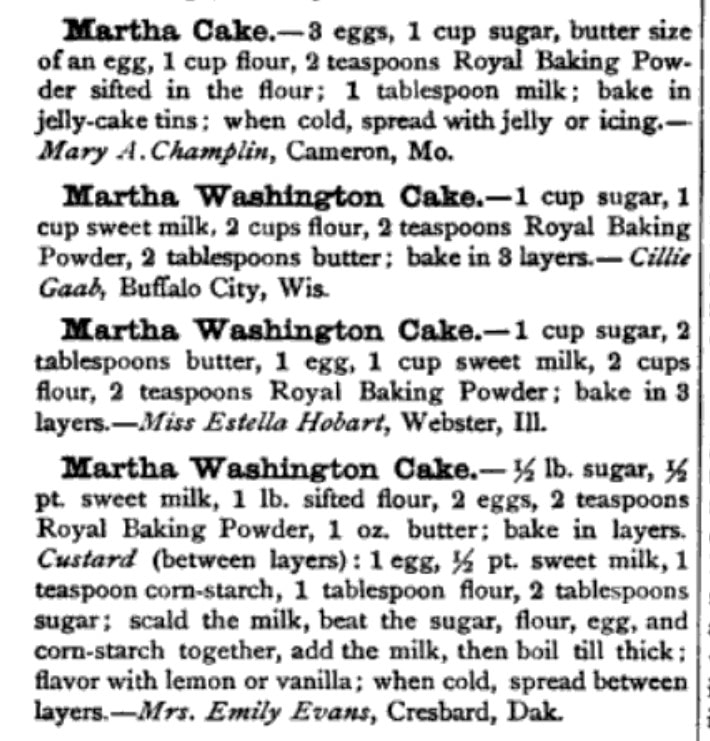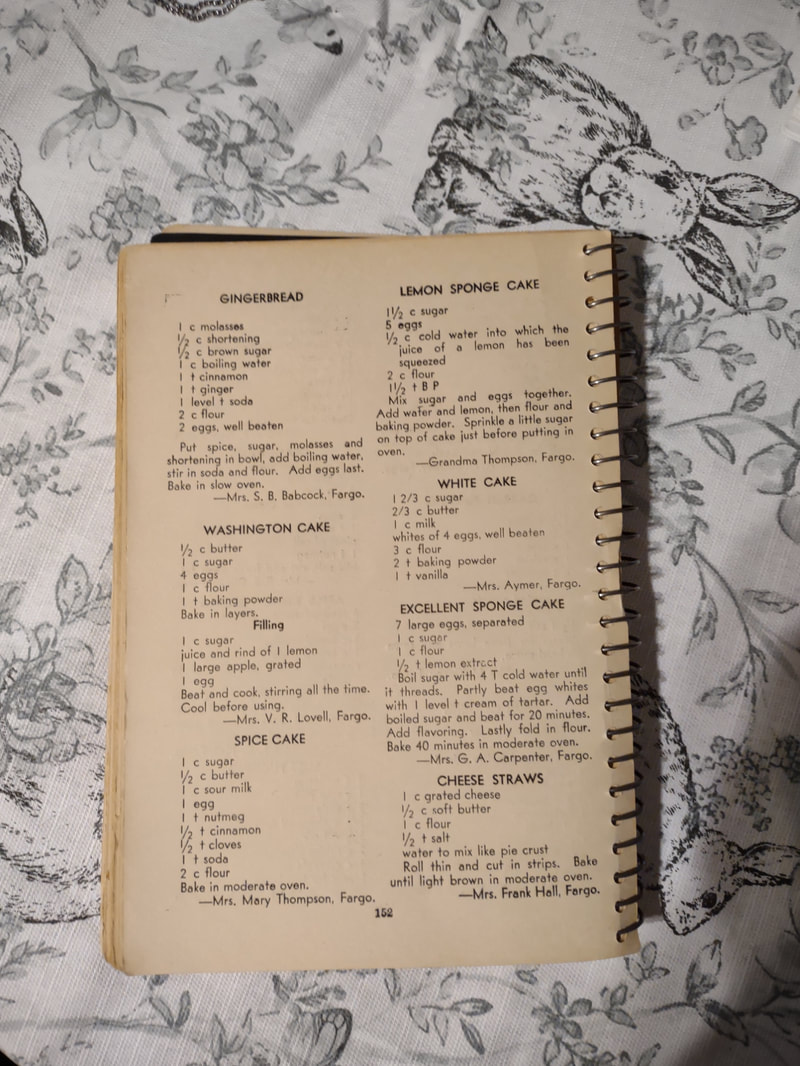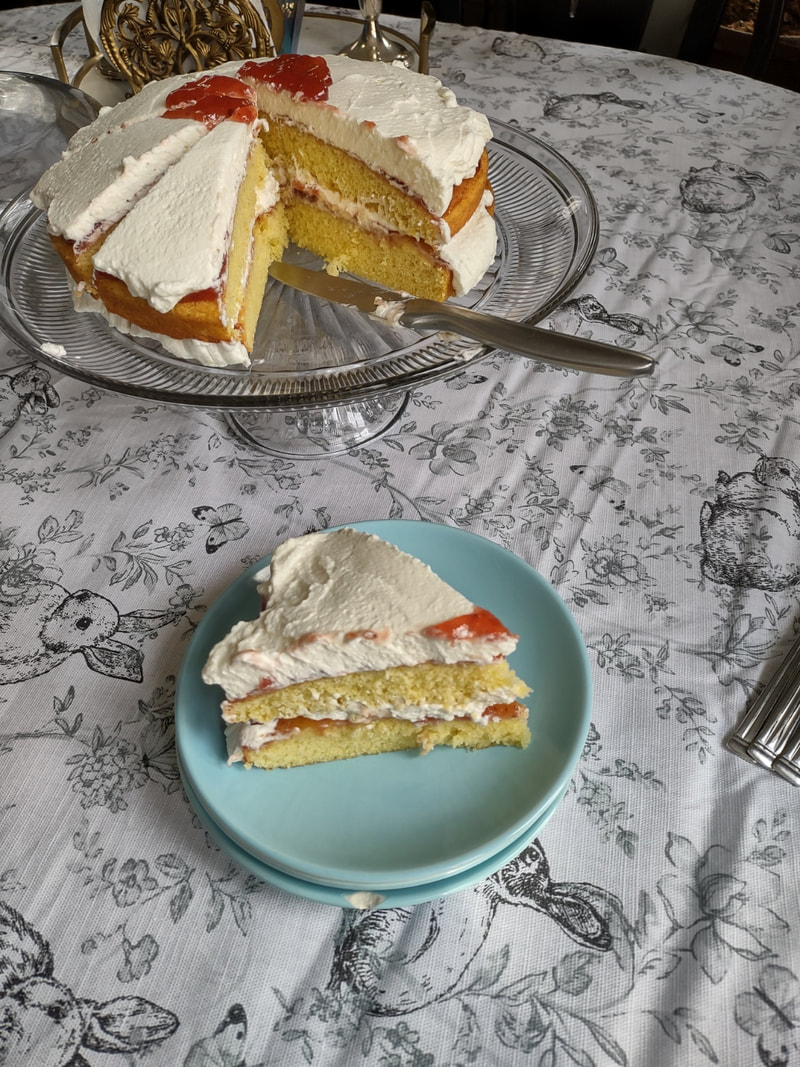Washington Pie HistoryWashington pie is everywhere in 19th century cookbooks. Confusingly, it is not a pie. Gastro Obscura traced the history of Washington pie, but spoiler alert - it was called a pie because it was baked in tin pie pans, which back then had straight sides similar to modern cake pans. WHY it was named after George Washington isn't clear - and the earliest references we can find date to 1850. Gastro Obscura and Patricia Reber trace it back to Mrs. Putnam's Receipt Book and Young Housekeeper, by Elizabeth H. Putnam and published in 1850. But I found another reference from 1850, the Practical Cook Book by Mrs. Bliss (of Boston), also published in 1850, for "No. 1 Washington Cake," which included the note "This cake is sometimes called WASHINGTON PIE, LAFAYETTE PIE, JELLY CAKE, &c." Mrs. Bliss' recipe is preceded by the lovely-sounding "Virginia Cake," which calls for sieved sweet potato and molasses, and "Victoria's Cake," which is a lemon-flavored sponge cake with no mention of the jam and cream commonly found in Victoria Sponge. I did find several earlier references to "Washington Cake," many of which were more a type of white fruit cake with currants (Mrs. Bliss' "No. 2 Washington Cake" is of this type), not a layer cake with jelly, with one exception. "Washington Cake" in Mrs. T. J. Crowen's 1845 Every Lady's Cook Book calls for a similar style cake flavored with lemon and brandy. However it does not say to bake it in layers, nor fill it with jam or jelly. But let's take a harder look at that "Layfayette Pie" reference from Mrs. Bliss. Lafayette Pie, Martha Washington Pie or Cake HistoryAlthough Washington Pie is traditionally made with only jam or jelly, there was another variation that shows up later: the Lafayette or Martha Washington Pie/Cake. Similar to Washington Pie, both "pies" are a simple cake baked in thin layers, but instead of filled with jelly or jam, are filled with custard (or more rarely, whipped cream). Confusingly, though the majority of references to Lafayette Pie and Martha Washington Pie call for custard, I have seen occasional references to jelly options, too. The above recipes, from My Favorite Receipt, published by the Royal Baking Powder Company in 1886 is one of the earliest references I can find to Martha Washington Cake/Pie. The first one, called just "Martha Cake" calls for it to be baked in "jelly-cake tins" and spread with "jelly or icing." The next two recipes are identical, and call for the cake to be baked in three layers, but no reference to fillings. The final version (from a North Dakotan!), is the one which also lists the cooked custard filling, to be flavored with vanilla or lemon. The earliest reference I could find for "Lafayette Pie" is Mrs. E. Putnam's 1867 version of her Mrs. Putnam's Receipt Book, which follows the Washington Cake recipe with "Lafayette Pie," a rather less precise recipe than Washington's, which is "enough for two pies" and is followed with "Filling for the Above Pies," seeming to mean both Washington and Lafayette. It reads "Two ounces of butter, quarter of a pound of sugar, two eggs, and one lemon; beat all together without boiling." At first, I read this to mean uncooked, but instead it must mean heated but not boiled - essentially a rich, lemon-flavored custard. The Methodist Cook Book, published in 1899, contains a recipe for "Lafayette Pie," which calls for being baked in a "Deep pie plate," and then cut in half lengthwise (confusingly, it says to "cut out the center to make room for the filling") and filled with a cornstarch-egg custard. Just like Martha's. Boston Cream Pie History As far as I can tell, Lafayette Pie and Martha Washington Pie/Cake are essentially the same: a simple layer cake baked in pie tins and filled with cooked custard. Sound familiar? Recipes called "Boston Cream Pie" were for decades exactly the same - a thin plain layer cake filled with a cooked custard. Contrary to what Gastro Obscura claims, when Americans made Boston Cream Pie at home in the 19th century, it was WITHOUT a chocolate topping. None of the 19th century recipes I could find titled "Boston Cream Pie" (and there were many) contain chocolate at all - only one Maria Parloa recipe calls for chocolate, and that is named "Chocolate Cream Pie." Chocolate-free Boston Cream Pie recipes continue to be published into the 1940s. As far as cookbooks go, Boston Cream Pie doesn't morph into the chocolate-topped version until the 20th century. The Home Dissertations cookbook, published in 1886, includes a recipe for "Boston Cream Pie" among its pastry recipes, even though it is clearly a cake. It calls for the cake to be baked in "round tins so that the cake will be one inch and a half thick" and filled with a cooked custard made with eggs and cornstarch, flavored with vanilla or lemon. No chocolate in sight. How or why all of these "pies" which are really cakes got their names remains lost to history. Likely, the cake was baked in honor of Washington's birthday, or other patriotic occasions. Washington's Birthday became a federal holiday in 1879, which may explain the popularity of the cake at the end of the 19th century. Lafayette and Martha likely followed as other patriotic homages. Other political figures also got their due, like this "Mrs. Madison's Cake" from 1855, which lists just above a white fruitcake-style "Washington's Cake," "Madison Cake" from 1856, and "Mrs. Madison's Whim," a similar-style cake "good for three months" stays in print as late as 1860. Even Jefferson got his own cake, although only in one 1865 edition of Godey's Magazine, and it reads more like a sweet biscuit than a true cake. Political cakes may have been a thing in the 19th century, because the 1874 The Home Cook Book of Chicago has an Adams Cake, a Clay Cake, two Harrison Cakes, and a Lincoln Cake, and the Adams and Clay cakes (named for President John Adams and Senator Henry Clay, one presumes) read very much like Washington Pie. There are also TWO recipes for "Washington Pie," one of which has a filling that includes apples. I could only find one other "Lincoln Cake" in the 19th century, published in 1863. And Boston? It could be that the patriotic cakes were simply popular in Beantown, which leant its name as the "pies" spread elsewhere (a la Boston Brown Bread, Boston Baked Beans, etc.). Certainly the Parker House Hotel in Boston claims to have invented Boston Cream Pie, although I've yet to see any hard evidence (like a recipe or period description) that indicates it had a chocolate topping in the 1860s. Victoria Sponge Cake HistoryWashington Pie really is quite similar to Victoria Sponge, which if you're a fan of the Great British Bakeoff, you know is one of Britain's (and Queen Victoria's) favorite desserts. And, ironically, not actually a sponge cake, as it calls for butter (true sponge cakes have no fat). Likely developed in the late 1840s, coinciding with the development of baking powder in 1843, and adopted by the Queen in mourning in the 1860s. Like Washington Cake, some of the first references to "Victoria Cake" are much closer to a white fruitcake or pound cake than a sponge, like this recipe from 1842, or this recipe from 1846 by Francatelli. The first recipe to a sponge-style Victoria Cake comes in 1838, the year after she became queen (recipe pictured above) from The Magazine of Domestic Economy. Although it does not call for filling of either jam nor whipped cream. The oft-cited recipe published in The Practical Cook (1845), is identical to the 1838 recipe, down to the letter. Of course, Mrs. Bliss' "Victoria's Cake," published in 1850, while not identical to the letter, is certainly just a slightly re-worded copy. Despite the popularity of the sponge, "Victoria's Cake" continues to be the yeasted fruitcake that Francatelli and later Soyer keep pushing well into the 1860s. "Victoria Sandwiches" come into play in the 1850s, whereby pieces of sponge cake are sandwiched with jam and topped with pink icing, a la The Practical Housewife, published in 1855 by Robert Kemp Philp. Ridiculously, Francatelli's version of "Victoria Sandwiches" are a literal sandwich, made with hard boiled egg and anchovies. Not quite as flattering to the queen. Mrs. Beeton wisely hops on the sponge cake "Victoria Sandwiches" bandwagon in the 1860s. Although curiously none of these early recipes call for whipped cream to accompany the jam. Perhaps because Mrs. Beeton's recipe for Victoria Sandwiches is immediately followed by one for Whipped Cream, maybe someone put two and two together. Which cake was inspired by whose we'll perhaps never know. Unless some manuscript cookbook has in it somewhere "Washington Pie, from Victoria's Cake" or "Victoria Sandwiches, in the style of Washington Pie." Regardless, it was the exact right kind of cake to associate with heads of state, apparently, once everyone got over heavy white fruit cakes laden with lemon and currants and alcohol. In making a birthday brunch for a friend, I wanted to focus on vintage recipes and had Washington Pie already in mind. But unwilling to use the internet (cheating!), I instead consulted my historic cookbooks. I had been on the lookout for another recipe, when I found a recipe for "Washington Cake" in one of my North Dakota community cookbooks, this one dating to the 1940s: The North Dakota Baptist Women's Cook Book. The cookbook does not have a publication date, but there is a reference to 1947 in the frontspiece, and from that and judging by the style of font and print, we can safely date it to the late 1940s, possibly 1950, but not much later. Interestingly, the recipe for Washington Cake was in a section in the back called "1905 Recipes" and dedicated to the women of the First Baptist Church of Fargo, ND, which was built in 1905. The recipes that follow were all written by women of the church for that first construction - likely from an older cookbook. The dedication reads, "In loving memory of those who have made a very definite contribution to the Christian cause through their labors in the First Baptist Church of Fargo, N. D., and who have left behind them fruits that are being utilized in this book, this page is gratefully dedicated." It then lists two biblical references to death and a list of women's names. The recipes read as much older than 1905, with emphasis on things like brown bread, suet pudding, doughnuts, gingerbread, and mincemeat. Likely they were submitted as "colonial" or similar "old-fashioned" recipes that were part of the popular colonial revival that began at the turn of the 20th century. The recipe for "Washington Cake" was contributed by Mrs. V. R. Lovell of Fargo, ND. It reads: 1/2 c butter 1 c sugar 4 eggs 1 c flour 1 t baking powder Bake in layers. Filling 1 c sugar juice and rind of 1 lemon 1 large apple, grated 1 egg Beat and cook, stirring all the time. Cool before using. Not exactly the most descriptive recipe I've ever read, but better than many! I decided not to use the interesting-sounding filling, although I may revisit it at a future date. Instead, I wanted to go the jam-and-cream route. 1905 Washington Cake (or Pie), AdaptedUnlike a traditional sponge cake, which can be quite finicky with separating egg whites, I found this recipe to be just as delicious, but much simpler. As an added bonus, you don't have to split a taller cake evenly lengthwise - the layers are already thin enough to stack as-is. You can use any kind of jam, but I chose my favorite brand of strawberry. 1/2 cup butter 1 cup sugar 4 eggs 1 cup flour 1 teaspoon baking powder 1 teaspoon vanilla (or lemon or extract) Strawberry jam Whipped cream Preheat the oven to 350 F. Butter well two round cake pans. Cream but the butter and sugar together, then add the eggs one at a time, beating after each addition. Add the vanilla (or lemon), then the flour and baking powder, then mix well until everything is well combined. Pour equal amounts into the two cake pans, then bake on the center rack for approximately 30 minutes (check after 20 - when the cake is golden at the edges and the center springs back to the touch, it is done). Tip the cakes out of their pans onto a cooling rack and let cool completely. Then spread strawberry jam on one layer, and top with whipped cream (I stabilized mine with cornstarch - which you could taste, so I would not recommend doing that again), then add the second layer, more strawberry jam, and more whipped cream. If you want this cake to keep better, I would recommend going the traditional Washington Pie route and just filling thickly with strawberry jam, and serving it with whipped cream on top to taste. This cake is very easy, bakes relatively quickly, and tasted delicious. It was VERY sweet, so I might cut back on the sugar slightly if I make it again. But while I'm sure Great British Bakeoff experts would criticize the fact that I didn't weigh my ingredients or make sure my eggs were room temperature, I thought the cake turned out very lovely indeed. And the combination of cake, whipped cream, and sweetened fruit can never be wrong. As for all the other political cakes? I may have to do some more investigative baking for Presidents' Day 2023. The Food Historian blog is supported by patrons on Patreon! Patrons help keep blog posts like this one free and available to the public. Join us for awesome members-only content like free digitized cookbooks from my personal collection, e-newsletter, and even snail mail from time to time! Don't like Patreon? You can leave a tip!
0 Comments
|
AuthorSarah Wassberg Johnson has an MA in Public History from the University at Albany and studies early 20th century food history. Archives
July 2024
Categories
All
|






 RSS Feed
RSS Feed